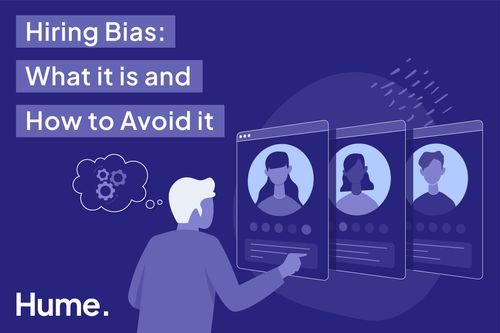Hiring Bias: What it is and How to Avoid it
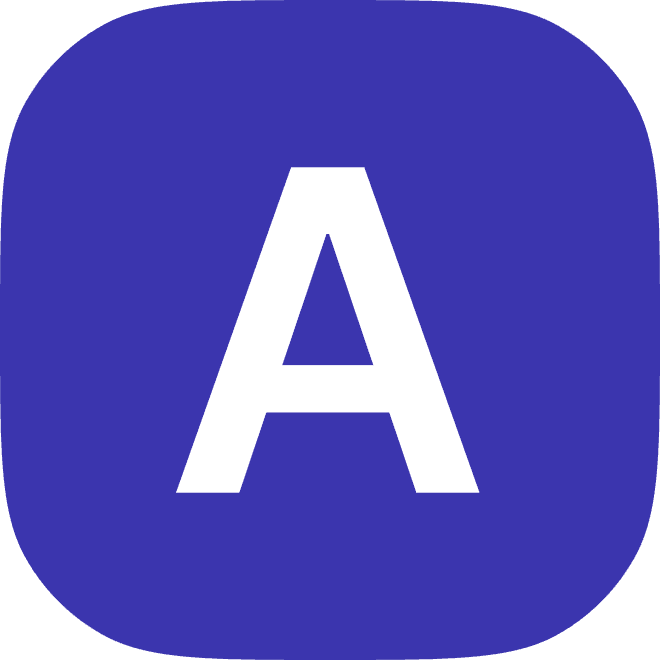
2023
Ever have a gut-feeling about someone? Or really liked (or disliked) a job candidate, all without quite being able to put your finger on why?
While conventional wisdom may advise you to trust that pesky intuition, there's a good chance it's dead wrong — making it a dangerous north star for recruiters and hiring managers intent on finding their ideal candidate.
You may even try your best to temper any quick-trigger judgments. But all humans are susceptible to them, often without even knowing. And when bias plays a role in hiring decisions, you run the risk of an unfair application process where you hire the wrong person, torpedo diversity initiatives, and keep your company from growing.
So let's talk about hiring bias. Learn about 10 of the different forms it takes, why fighting it is so important, and how to ensure biases never play an out-sized role in your personnel decisions.
What is hiring bias?
Hiring bias refers to the hasty judgments and gut feelings people make when evaluating whether a candidate is fit for a job. These biases are often formed based on unspoken (read: unfair) criteria that have little to do with the underlying role.
Things like the college a job seeker went to, inflection in their voice, or even the color of their shirt, can all play an implicit role in whether they get hired — since humans form opinions immediately (literal milliseconds!) after first impressions.
Sometimes hirers make these judgments consciously, while other times they fall prey to unconscious bias, making said judgments more subtle and harder to regulate.
Harboring some degree of implicit bias is unavoidable. It's a heuristic, or mental shortcut the human brain employs to seek patterns in the world and process information in social situations.
Learn about how bias impacts the interview process is our comprehensive guide, here.
10 Common hiring biases
Recruiters and hiring managers are vulnerable to biased judgements across every stage of the candidate journey. While interview bias can rear its ugly head later on in the hiring process, the judgments can be formed as soon as you read a name on a resume. Here's a quick primer on some to look out for.
Confirmation bias. Asking irrelevant questions in an attempt to confirm a snap assumption you previously made about a candidate.
Halo effect. When one positive candidate attribute out-shines several weaker candidate attributes.
Horn effect. Also known as the pitchfork effect, when one negative candidate attribute clouds several stronger candidate attributes.
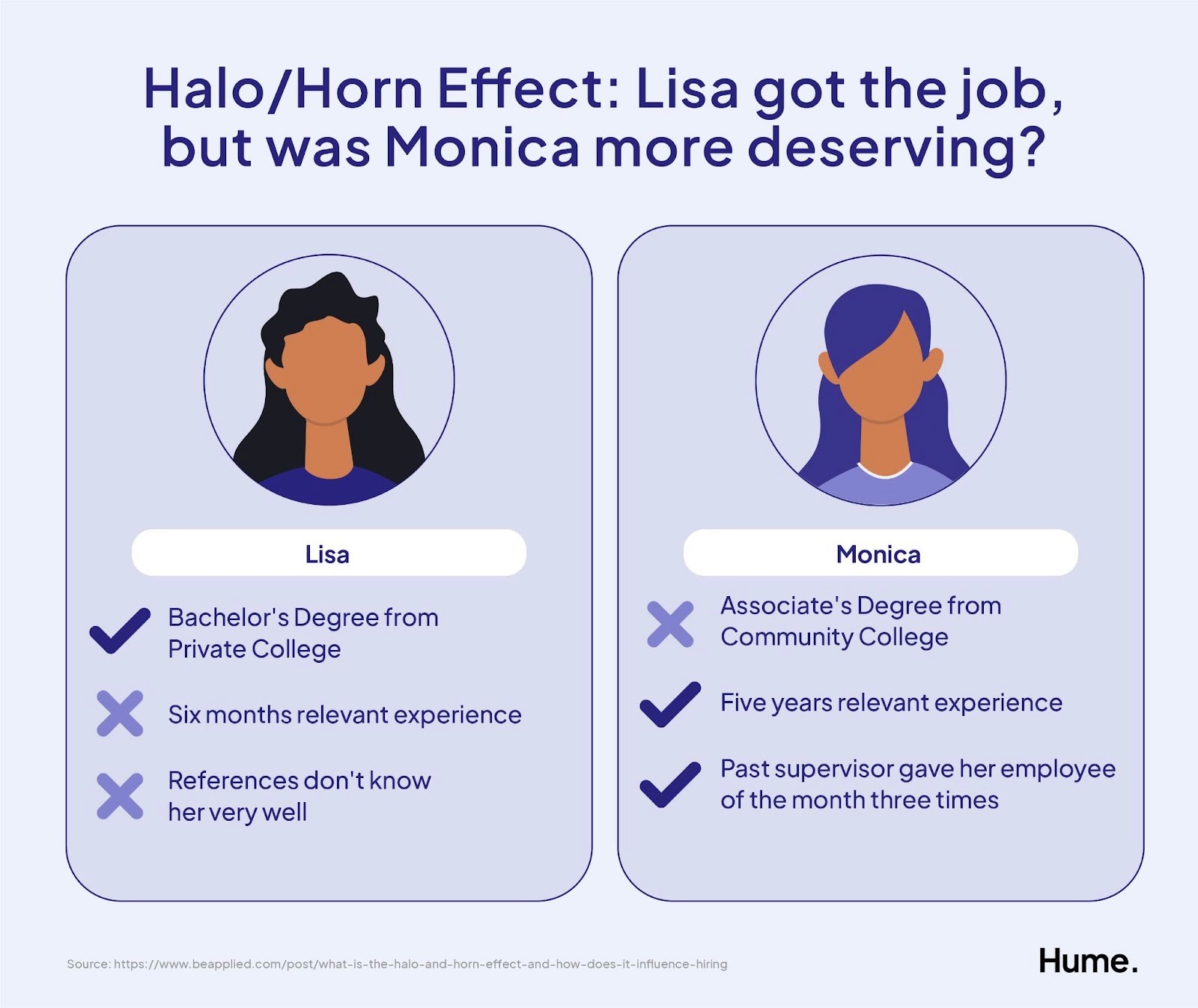
Affinity bias. Also known as similarity bias, this is when recruiters and hiring managers prefer job seekers they share something in common with.
Name bias. Unconsciously judging people, favorably or unfavorably, with certain types of names. Research shows that Emilys and Gregs are likelier to get hired than Lakishas and Jamals.
Age bias. Judging candidates based on how old they are.
Conformity bias. When hirers succumb to peer pressure and either favor or disfavor a candidate because of a group consensus that they may individually disagree with.
Contrast effect. When your judgment of an application is heavily influenced by the candidate you looked at previously.
Intuition bias. This is the "trust your gut" fallacy, which occurs when you have an abstract feeling about someone that isn't based on any concrete facts.
Beauty bias. Judging a candidate based on their looks, and favoring job seekers who are conventionally attractive. Research shows attractive individuals have a competitive edge.
Why it's important to mitigate hiring bias
As mentioned, holding unconscious biases is a part of what makes us human.
But when you let these individual snap judgments seep into collective decision-making, that's when you run into trouble. Especially during the recruitment process.
Bias can cloud objective reasoning and lead to subjectively hiring the wrong candidate, which can cost your company nearly a third of said bad hire's first year earnings. What's more, hiring bias can be a huge drain on workplace diversity, which 76% of candidates consider during their job search.
And diversity is about so much more than your company's reputation. According to the Harvard Business Review, research shows it improves problem solving, innovation, and strategic planning. Also, since talented candidates want diverse workplaces, less homogenous companies will see productivity gains and, yes, revenue boosts.
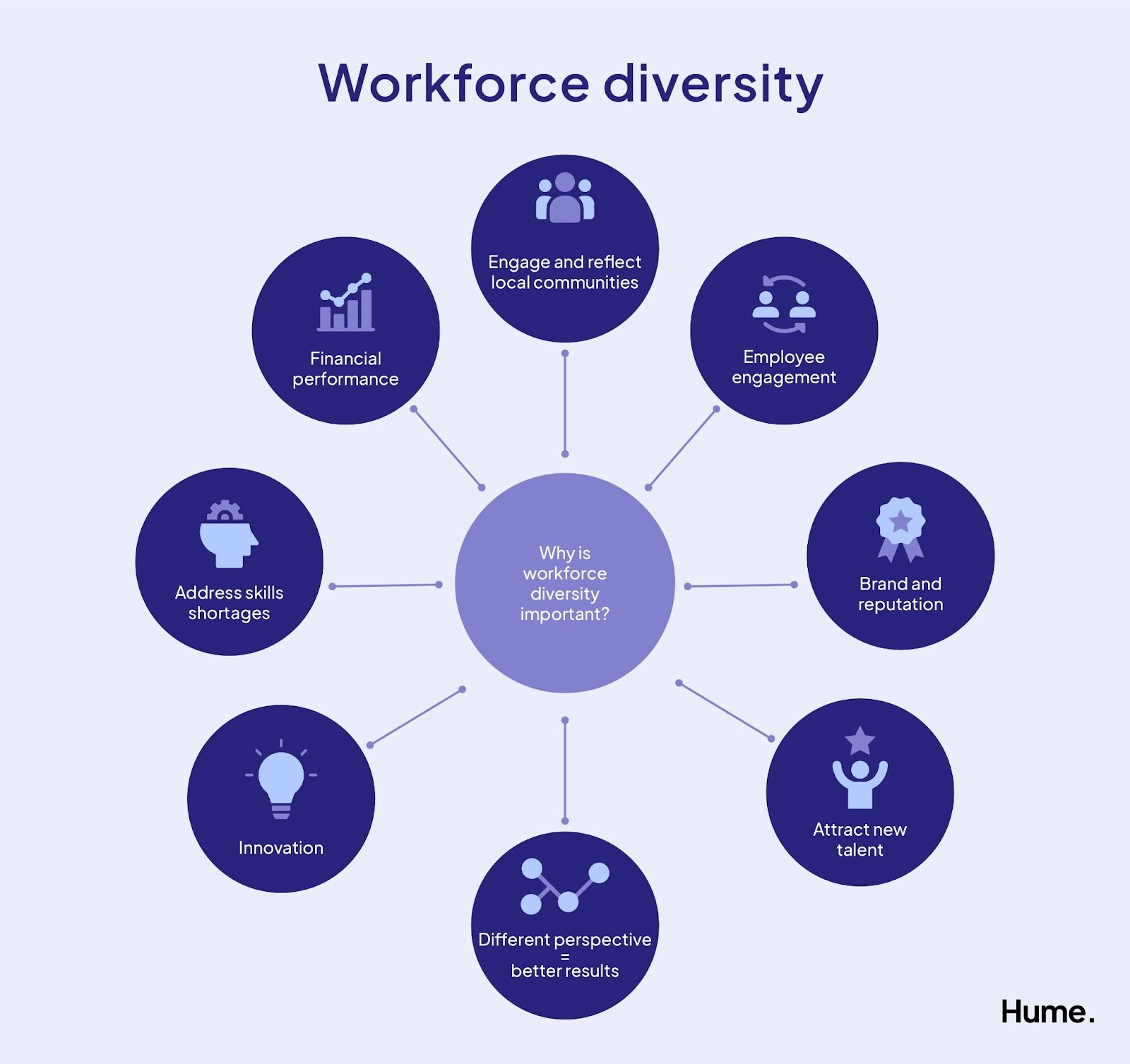
Even the slightest bias can have disastrous consequences for your business. According to research from Oregon State University, a Fortune 500 company that hires 8,000 employees each year can expect 192 failed hires and $17 million lost in productivity — all with just a 4% bias effect.
8 methods to reduce bias in your hiring decisions
With free rein, biased hiring can wreak havoc on your company morale and bottom line. But with the right guardrails in place, you can ensure recruiters and hiring managers never succumb to any hasty or unfair judgments. Here are tried-and-true ways to dismantle hiring bias across different stages of the candidate journey.
Train your hiring team
First things first: every colleague in your hiring team needs to know about implicit bias. At minimum, this means ensuring all recruiters are well aware they're susceptible to biases.
Harvard's Project Implicit is a great starting resource, as users can test themselves on which unconscious biases they have across demographic groups. But training programs go beyond just awareness. The more you can coach hirers to adopt new perspectives and look beyond flawed stereotypes, the easier time they'll have counteracting unconscious and conscious bias.
Recruit broadly
To reduce bias, you need to be both flexible and inclusive in the kind of candidates you're looking for. You'll have a more diverse hiring pool if you look beyond conventional recruiting channels. So you shouldn't limit your search to a geographical location or solely rely on word-of-mouth networking.
With that in mind, it helps to design an accessible hiring process. For instance, seeing as how more than 80% of candidates browse jobs on their phones, consider a mobile-friendly application. If you want a diverse talent pool, you can also advertise your opportunity with organizations that try to bolster job access for underrepresented groups — say, reaching out to the Black Code Collective for help filling a software developer role.
Refine your job descriptions
Job descriptions can be tricky. You want to appeal to a broad range of candidates — all while ensuring recruiters and job seekers are on the same page about the role. And if you're not careful about wording, you can unintentionally unearth bias.
Research shows that job descriptions can perpetuate gender inequality in male-dominated fields by employing masculine-coded wording — terms like "leader," "competitive," and "dominant." And while women are less likely to apply to jobs advertised with wording aligned with male stereotypes, research also shows that words like "collaborative," and "cooperative," draw more women than men.
So check the language in your job description and make sure you're using inclusive, neutral wording. If you're stuck, some online tools, like Robert Walters' Adify, can ensure you're steering clear of gendered wording.
Keep in mind that it's also best practice to define the job, not the person in your description. This way, you're avoiding hiring someone based on personality traits that have nothing to do with job performance.
Anonyme resumes
Resume screening is one of the most susceptible stages of the application process to hiring bias. Consciously or not, biographical information like a candidate's name, address, hobbies, and graduation year can cause recruiters to make quick-trigger judgments that impair their objectivity.
So consider blotting out some of this identifying information. If you "blind" resumes (and even some parts of the overall application), you'll boost the likelihood of finding the best candidate based on merit instead of based on preference. If you're dealing with a high volume of applications, software programs like GapJumpers will blind the different parts of the application for you.
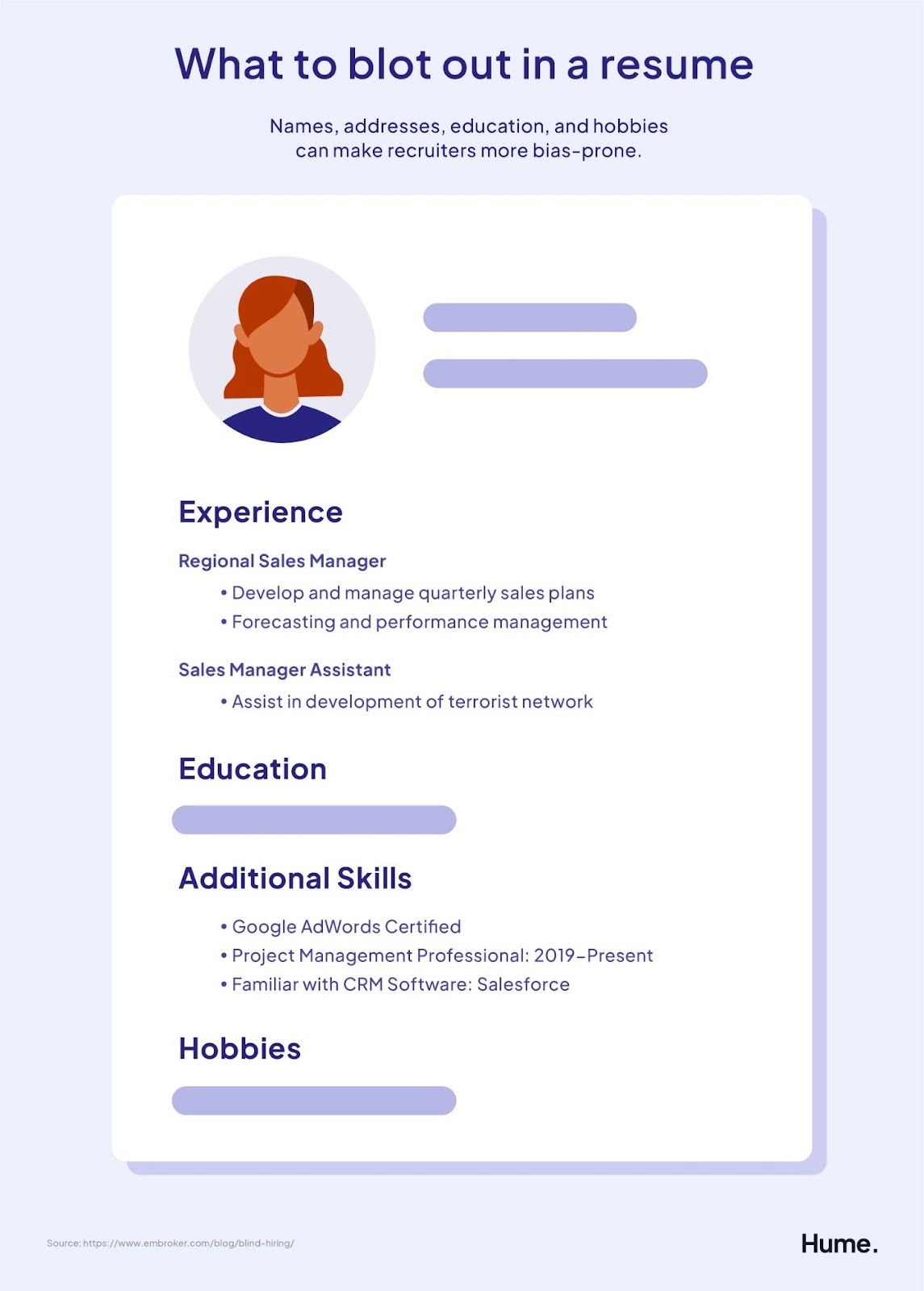
At first glance, this may feel over-the-top, but it's a methodology recommended by many hiring experts. And that's because it works. According to GapJumpers data, when companies went from conventional resume screening to blind resume screening, the amount of candidates who were not white, male, or able-bodied that made it to the next round of applications jumped from 20% to 60%. Blind screenings also made women's research pitches likelier to get accepted at Hubble Space Telescope.
"Flip it to test it"
In a 2016 TEDTalk, a human resources leader named Kristen Pressner suggested that, to combat unconscious hiring bias, you should "mentally flip whoever you're dealing with for someone else to test yourself…" If it feels odd after the fact, you may have uncovered a bias.
This "flip it to test it" approach helps recruiters challenge their preconceived notions by seeing if they hold merit from a different perspective.
For instance, if you're interviewing a female candidate and find that she came off as too domineering in her answers, this mental exercise asks you to, say, switch that job seeker's gender: would you cast that same judgment if she were a man? It's a nifty way to double-check those gut reactions and see if you're unconsciously harboring bias.
Give a work sample test
So you meet a smooth-talking candidate from your hometown, who's good friends with someone you hold dear. How do you overcome affinity bias and evaluate whether they're an actual good candidate for the job?
If you want to gauge a candidate's ability, you can always assess their actual skills. By giving job seekers a real work-related problem you're dealing with, or by giving them a project that simulates what their actual job would entail, you can look beyond surface-level biases and get to the heart of what kind of employee they'd be.
Involve a team of diverse colleagues in the hiring process
A diverse hiring team begets a diverse hiring pool. So if you're looking to dismantle bias and source diverse candidates with a recruitment panel made up of people who all look the same, you'll likely fail before you even start.
Ideally, your hiring committee includes colleagues across different ethnicities, ages, genders, and sexual orientations. You can also hire a Chief Diversity Officer to ensure enough hirers and qualified candidates come from underrepresented backgrounds.
When it comes to reducing bias, there's also strength in numbers. The more colleagues you rope into the job search, the likelier your team is to catch blindspots and challenge any hasty judgments. Just keep in mind that it helps if your team members evaluate candidates individually before deliberating collectively (to best steer clear of conformity bias).
Of course, not every hiring team member will be able to personally meet all your standout candidates, so it helps if you can record virtual interviews to share and revisit later. But more on that in just a moment…
Structure the interview
Some hiring decision-makers like to "wing it" when interviewing candidates. They ask different, meandering questions to different candidates, depending on how the conversation is going (or whether they "like" them). They rely on flighty intuition instead of objective criteria, injecting too much chitchat into the fold whenever they share things in common with the interviewee.
Tempting as it may be to have these sort of free-wheeling conversations, unstructured interviews don't just exacerbate interview bias. They're also terrible barometers, predicting just 14% of an employee's performance. According to some data of salespeople, unstructured interviews are no better than aptitude and personality tests (both of which are weak predictors themselves).
So what to do? Add structure to your interview process. By that we mean asking every candidate the same exact questions, grading everyone according to the same exact rubric.
This way, every job seeker gets an equal opportunity to prove why they're a good fit for your role. Plus, you're using the data-driven insights culled from the interview to make the right hire, instead of relying on any gut feelings.
That said, structured interviews aren't always easy to pull off all on your own. It helps if you have a complete record of every interview that you can easily annotate and distribute across your hiring panel.
That's exactly what we created at Hume, a talent platform that records, transcribes, and tags interviews using artificial intelligence.
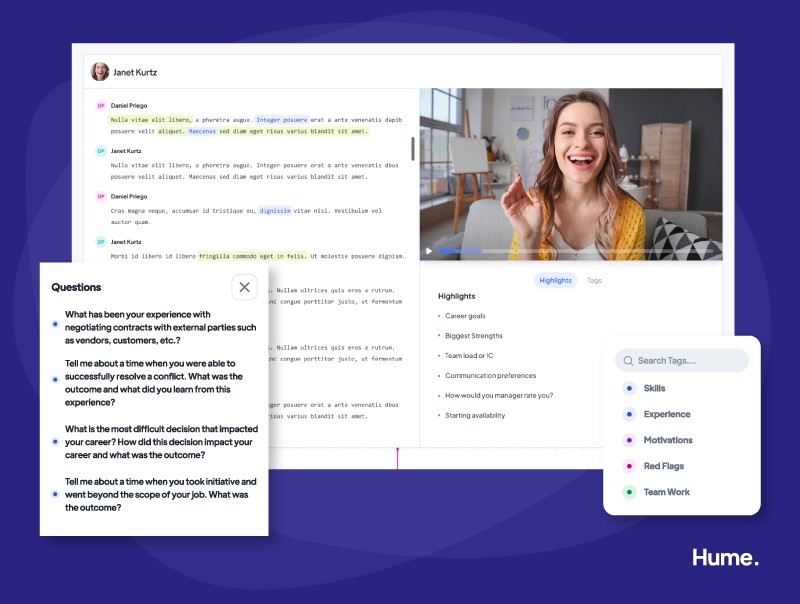
Instead of jotting down disjointed notes, Hume lets you focus on the candidate while the entire conversation gets recorded. AI extracts every question interviewers ask from the transcript, so you can ensure you're asking different job seekers the same prompts to reduce bias.
After the interview, you can annotate the transcripts, tagging parts of the conversation that speak to a candidate's core competencies, experience, and motivations for easy access across your hiring panel.
Our interview companion also lets you "highlight" snippets of the recorded video conversations with job seekers to share with your hiring committee, so that everyone involved can evaluate candidates without having to speak with them directly, or watch an entire 45-minute interview. You can even showcase different candidates side by side (as shown below), to seamlessly compare how standout members of your talent pool answered the same question.
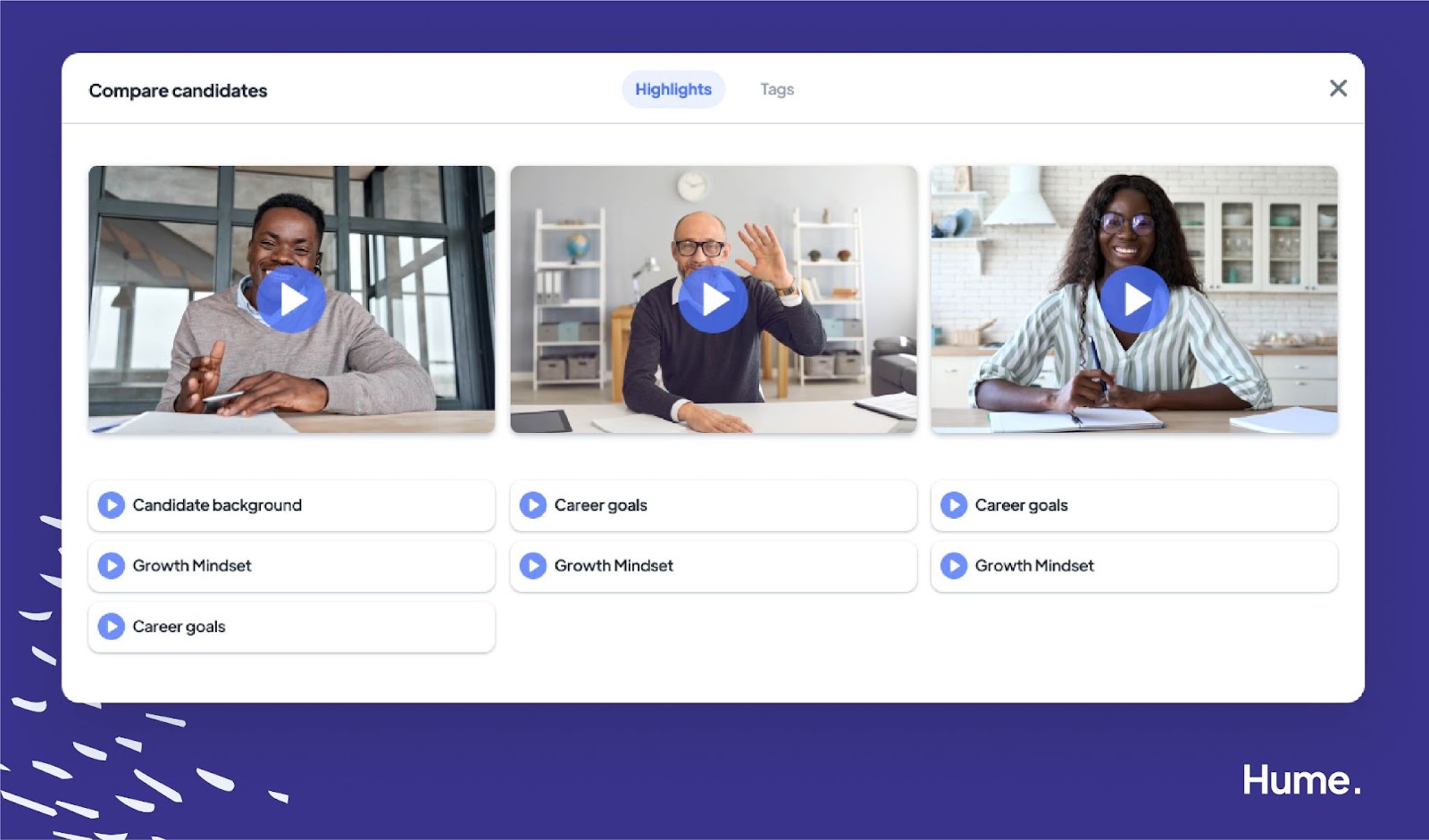
Hume also provides helpful interview metrics — things like speaking vs. listening ratios, longest monologue, and speech pace — which help you make more informed, data-driven decisions. You can even curate coaching libraries to ensure every interviewer is informed of best practices, bias awareness, and is always asking the right interview questions — ones that convey behavior instead of personality.
The result is a hiring process free of friction and full of insight. You'll find top talent, improve candidate experience, and decrease time to hire — all while removing any sneaky biases from interviews.
Bias doesn't have to hold you back
We're only human. Whether we like it or not, we all use mental shortcuts that make us cast judgments too quickly and less than fairly.
But that's never a good reason to let bias influence your company's hiring decisions. There's too much at stake. So sign up for Hume today and get early access to the tool that minimizes bias and helps you find your best candidate. And follow us on LinkedIn for more insights on how to improve your hiring practices to better cultivate a talented and diverse workforce.

